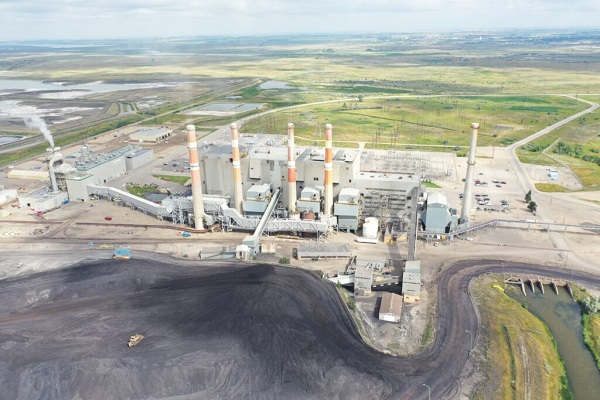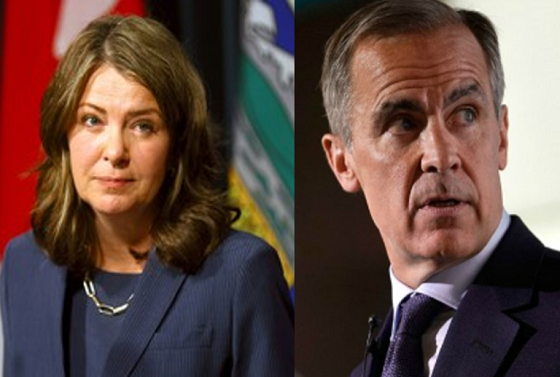Energy
A plan to save coal, power generation, and the oil industry in southeast Saskatchewan

From the Frontier Centre for Public Policy
Stop moving to shut down Saskatchewan coal – it could be the salvation of our oil industry
What if there was a way to keep coal mining jobs in Saskatchewan, continue to produce low-cost electrical power, and extend the production of a substantial portion of Saskatchewan’s oilfields not by decades, but by generations? And in doing so, we could still dramatically reduce carbon dioxide emissions, and maybe save some money by reducing our nuclear rollout?
All of this is now possible, and it has everything to do with keeping our coal miners digging and our coal-fired power plants going, maybe even renewing them.
There was a potentially major development for Saskatchewan’s energy sector buried in Whitecap Resources Inc.’s year-end financial report released on Feb. 21. Whitecap said about using CO2 for enhanced oil recovery, “We have also recently started CO2 injection at a pilot CO2 flood into the Frobisher formation underlying the Weyburn Midale unit. We drilled two (2.0 net) producer wells and three (3.0 net) injection wells in 2023 and initiated CO2 injection in late 2023. Early results are encouraging with a notable production response coming through approximately one month after injection, increasing oil rates on the two producer wells from approximately 40 bpd to over 200 bpd, per well. Further technical analysis to determine commerciality and large-scale development is ongoing, and we will provide updates as next steps are determined.”
While the Bakken formation got all the headlines starting around 2007, the reality is in southeast Saskatchewan, very few Bakken wells are drilled these days. Most of the activity has been Frobisher wells, especially around Steelman, where it has been targeted for decades. So if the Frobisher responds well to tertiary recovery through carbon dioxide floods, it opens up a lot of possibilities for extending the life of some of Saskatchewan’s most prolific oilfields, taking recovery rates from the mid-20 per cent range to over 50 per cent.
Back in 2012, Canadian Natural Resources Limited president and CEO Steve Laut expressed interest in using CO2 for enhanced oil recovery in the Steelman Unit.
Whitecap’s initial results were not a five per cent improvement, or 50 per cent, but five times higher. That’s something everyone, including the provincial government, should take notice of. Imagine if you could increase crop production from 60 bushels to the acre to 300 bushels? Or quintuple potash or uranium production from certain mines? You’d be an idiot to not at least take a hard look at it.
I’m not suggesting it will remain anywhere close to that level, but the fact the CO2 flood in the Weyburn Unit, in the Vuggy and Marly units of the Midale formation, has already dramatically increased recovery rates and lengthened the lifespan of a field that otherwise would have long gone dry is significant. If the same process can be expanded to the much more prolific Frobisher formation, that’s a very big deal.
Even if it was a 25 per cent improvement – that’s well worth investigating.
Frobisher is a big deal
How prolific is the Frobisher?

Most of the drilling activity in southeast Saskatchewan follows a certain pattern. The majority is along the Frobisher subcrop – the edge of the formation where it pinches out, forming a structural trap. Of the 16 rigs working in Saskatchewan on March 3, it’s a good bet 10, and possibly more, were drilling Frobisher wells. The daily well report for March 3 published by the Ministry of Energy and Resources shows out of 19 wells listed that day in Estevan area of responsibility, all 19, across five oil producers, were either targeting the Frobisher. It may be a fluke all that day showed the Frobisher, but it definitely shows its significance.
So if Whitecap, which has been growing to be one of Saskatchewan’s largest oil producers, has found a way to substantially increase production from this formation, shouldn’t we take a hard look at how we can take advantage of it?
Stop the process of winding down coal
There’s one thing we should do right now – stop this idea of shutting down our coal-fired power plants near Estevan. You hardly hear SaskPower mention coal-fired power anymore. I keep hearing how those plants are getting enough maintenance to just get them to the planned phase out of 2030, but not likely a day beyond that. The way things are going, they’ll likely limp to the finish line, but not an inch past that. Similar things are said to me about the mines and their iron.
I’m suggesting we should strongly reconsider that. Pour some money into keeping both the power plants and the mines viable should we choose to extend their lives beyond 2030.
The Government of Saskatchewan and SaskPower should have some real serious discussions with Whitecap, and possibly other oil companies like CNRL, about the possibility of dramatically increasing carbon capture and producing as much CO2 as we can. That means putting carbon capture on Shand Power Station. But it could also mean either refurbishing Boundary Dam Unit 6 or, shockingly, building Shand Unit 2, and maybe even Unit 3, with High Efficiency Low Emissions (HELE) technology, designed from the ground up with carbon capture running from Day 1.
One might say that’s going to cost billions, and you’d be right. But I dare say doing so will cost less than just one 300 megawatt small modular reactor, whose price is not yet known, but previous SaskPower Minister Don Morgan said could run between $3 and $5 billion.
It’s going to take a long time to squeeze the first megawatt out of that first reactor. If everything goes to plan (and it never, ever goes to plan with nuclear), we might see the first SMR megawatt around 2034-35. Putting CCS on our existing coal fleet, and maybe, dare I say, expanding it, with HELE and CCS, could help bridge the gap in the interim until we get several SMRs up and running, and have become proficient in their operation. That’s baseload power that won’t go to zero like wind does every so often, and solar does every night.
Doing so would keep the Estevan economy rolling, not just from coal mining and power generation, but also oil production.
I’ve been writing about the Saskatchewan oil industry for almost 16 years now, and I am increasingly alarmed by the fact I haven’t seen the “next big thing,” in southern Saskatchewan. Drilling numbers keep on their slow decline. Companies like Crescent Point have largely lost interest and are pouring their capital expenditure money into exciting Alberta plays. That may be great for Alberta, but Saskatchewan needs to do something to keep things going here. That we’ve kept oil production relatively flat for the last 23 years is a small miracle. But if we don’t get a lot more new investment, it won’t stay that way.
The Sask Party provincial government a few years ago set a bold goal of increasing oil production from the current 454,000 barrels per day to 600,000 barrels by 2030. I asked Premier Moe about that in my year end interview with him last December. He said he thought it was a modest goal.
But as I pointed out to him, and Energy and Resources Minister Jim Reiter, I’m not seeing evidence of the province moving to make that happen.
This is something the Government of Saskatchewan, through its Crown corporation SaskPower, can do. If we tell the feds to stick it when it comes to shutting down coal by 2030, if we put carbon capture on existing units and even build new coal units with carbon capture, then supply that CO2 to companies like Whitecap, and maybe others like Canadian Natural Resources Limited, we could extend the life of our most prolific play in southeast Saskatchewan. We might even increase its production while we’re at it. All the while, we’d be ensuring baseload power production.
This plan’s impact would be measured in generations, not an election cycle, or a corporate quarter.
And it might also save us some money by reducing our nuclear expenditure.
But action has to be taken now. Because if we let those power plants and mines slide past the point of no return, an opportunity may be lost that we will be kicking ourselves for later.
We can’t let that happen.
Brian Zinchuk is editor and owner of PipelineOnline.ca, and occasional contributor to the Frontier Centre for Public Policy. He can be reached at [email protected].
Bruce Dowbiggin
Integration Or Indignation: Whose Strategy Worked Best Against Trump?

““He knows nothing; and he thinks he knows everything. That points clearly to a political career.” George Bernard Shaw
In the days immediately following Donald Trump’s rude intervention into the 2025 Canadian federal election— suggesting Canada might best choose American statehood— two schools of thought emerged.
The first and most impactful school in the short term was the fainting-goat response of Canadian’s elites. Sensing an opening in which to erode Pierre Poilievre’s massive lead in the 2024 polls over Justin Trudeau, the Laurentian elite concocted Elbows Up, a self-pity response long on hurt feelings and short on addressing the issues Trump had cited in his trashing of the Canadian nation state.
In short order they fired Trudeau into oblivion, imported career banker Mark Carney as their new leader in a sham convention and convinced Canada’s Boomers that Trump had the tanks ready to go into Saskatchewan at a moment’s notice. The Elbows Up meme— citing Gordie Howe— clinched the group pout.

(In fact, Trump has said that America is the world’s greatest market, and if those who’ve used it for free in the past [Canada] want to keep special access they need to pay tariffs to the U.S. or drop protectionist charges on dairy and more against the U.S.)
The ruse worked out better than they could have ever imagined with Trump even saying he preferred to negotiate with Carney over Poilievre. In short order the Tories were shoved aside, the NDP kneecapped and the pet media anointed Carney the genius skewing Canada away from its largest trade partner to the Eurosphere. We remain in that bubble, although the fulsome promises of Carney’s first days are now coming due.
Which brings us to the second reaction. That was Alberta premier Danielle Smith bolting to Mar A Lago in the days following Trump’s comments. Her goal was to put pride aside and accept that a new world order was in play for Canada. She met with U.S. officials and, briefly, with Trump to remind them that Canada’s energy industry was integral to American prosperity and Canadian stability.
Needless to say, the fainting goats pitched a fit that not everyone was clutching pearls and rending garments in the wake of Trump’s dismissive assessment of his northern neighbours. Their solution to Trump was to join China in retaliatory tariffs— the only two nations to do so— and to boycott American products and travel. Like the ascetic monks they cut themselves off from real life. Trump has yet to get back to Carney the Magnificent

And Smith? She was a “traitor” or a “subversive” who should be keel hauled in the North Saskatchewan. For much of the intervening months she has been attacked at home in Alberta by the N-Deeps and in Ottawa by just about everyone on CBC, CTV, Global and the Globe & Mail. “How could she meet with the Cheeto?”
Nonetheless conservatives in the province moved toward a more independence within Canada. Smith articulated her demands for Alberta to prevent a referendum on whether to remain within Confederation. At the top of her list were pipelines and access to tidewater. Ergo, a no-go for BC’s squish premier David Eby who is the process of handing over his province to First Nations.
It became obvious that for all of Carney’s alleged diplomacy in Europe and Asia (is the man ever home?) he had a brewing disaster in the West with Alberta and Saskatchewan growing restless. In a striking move against the status quo, Nutrien announced it would ship its potash to tidewater via the U.S., thereby bypassing Vancouver’s strike-prone, outdated port and denying them billions.

Suddenly, Smith’s business approach began making eminent good sense if the goal is to keep Canada as one. So we saw last week’s “memorandum of understanding” between Alberta and Ottawa trading off carbon capture and carbon taxes for potential pipelines to tidewater on the B.C. coast. A little bit of something for everyone and a surrender on other things.
The most amazing feature of the Mark Carney/Danielle Smith MOU is that both politicians probably need the deal to fail. Carney can tell fossil-fuel enemy Quebec that he tried to reason with Smith, and Smith can say she tried to meet the federalists halfway. Failure suits their larger purposes. Which is for Carney to fold Canada into Euro climate insanity and Smith into a strong leverage against the pro-Canada petitioners in her province.
Soon enough, at the AFN Special Chiefs Assembly, FN Chief Cindy Woodhouse Nepinak told Carney that “Turtle Island” (the FN term for North America popularized by white hippy poet Gary Snyder) belongs to the FN people “from coast to coast to coast.” The pusillanimous Eby quickly piped up about tanker bans and the sanctity of B.C. waters etc.
Others pointed out the massive flaw in a plan to attract private interests to build a vital bitumen pipeline if the tankers it fills are not allowed to sail through the Dixon Entrance to get to Asia.
But then Eby got Nutrien’s message that his power-sharing with the indigenous might cause other provinces to bypass B.C. (imagine California telling Texas it can’t ship through its ports over moral objections to a product). He’s now saying he’s open to pipelines but not to lift the tanker ban along the coast. Whatever.
Meanwhile the kookaburras of isolation back east continue with virtue signalling on American booze— N.S. to sell off its remains stocks — while dreaming that Trump’s departure will lead to the good-old days of reliance on America’s generosity.
But Smith looks to be wining the race. B.C.’s population shrank 0.04 percent in the second quarter of 2025, the only jurisdiction in Canada to do so. Meanwhile, Alberta is heading toward five million people, with interprovincial migrants making up 21 percent of its growth.
But what did you expect from the Carney/ Eby Tantrum Tandem? They keep selling fear in place of GDP. As GBS observed, “You have learnt something. That always feels at first as if you have lost something.”
Bruce Dowbiggin @dowbboy is the editor of Not The Public Broadcaster A two-time winner of the Gemini Award as Canada’s top television sports broadcaster, his new book Deal With It: The Trades That Stunned The NHL And Changed hockey is now available on Amazon. Inexact Science: The Six Most Compelling Draft Years In NHL History, his previous book with his son Evan, was voted the seventh-best professional hockey book of all time by bookauthority.org . His 2004 book Money Players was voted sixth best on the same list, and is available via brucedowbigginbooks.ca.
Business
Canada’s climate agenda hit business hard but barely cut emissions

This article supplied by Troy Media.
 By Gwyn Morgan
By Gwyn Morgan
Canada is paying a steep economic price for climate policies that have delivered little real environmental progress
In 2015, the newly elected Trudeau government signed the Paris Agreement. The following year saw the imposition of the Pan-Canadian Framework on Clean Growth and Climate Change, which included more than 50 measures aimed at “reducing carbon emissions and fostering clean technology solutions.” Key among them was economy-wide carbon “pricing,” Liberal-speak for taxes.
Other measures followed, culminating last December in the 2030 Emissions Reduction Plan, targeting emissions of 40 per cent below 2005 levels by 2030 and net-zero emissions by 2050. It included $9.1 billion for retrofitting structures, subsidizing zero-emission vehicles, building charging stations and subsidizing solar panels and windmills. It also mandated the phaseout of coal-fired power generation and proposed stringent emission standards for vehicles and buildings.
Other “green initiatives” included the “on-farm climate action fund,” a nationwide reforestation initiative to plant two billion trees, the “Green and Inclusive Community Buildings Program” to promote net-zero standards in new construction, and a “Green Municipal Fund” to support municipal decarbonization. That’s a staggering list of nation-impoverishing subsidies, taxes and restrictions.
Those climate measures come at a real cost to the industry that drives the nation’s economy.
The Trudeau government cancelled the Northern Gateway oil pipeline to the northwest coast, which had been approved by the Harper government, costing sponsors hundreds of millions of dollars in preconstruction expenditures. The political and regulatory morass the Liberals created eventually led to the cancellation of all but one of the 12 LNG export proposals.
Have all those taxes and regulatory measures reduced Canada’s fossil-fuel consumption? No. As Bjorn Lomborg has reported, between the election of the Trudeau government in 2015 through 2023, fossil fuels’ share of Canada’s energy supply increased from 75 to 77 per cent.
That dismal result wasn’t for lack of trying. The Fraser Institute has found that Ottawa and the four biggest provinces have either spent or forgone a mind-numbing $158 billion to create just 68,000 “clean” jobs, increasing the “green economy” by a minuscule 0.3 percentage points to 3.6 per cent of GDP at an eye-watering cost of more than $2.3 million per job.
That’s Canada’s emissions reduction debacle. What’s the global picture? A decade after Paris, 80 per cent of the world’s energy still comes from fossil fuels. World energy demand is up 150 per cent. Canada, which produces roughly 1.5 per cent of global emissions, cannot influence that trajectory. And, as Lomborg writes: “achieving net zero emissions by 2050 would require the removal of the equivalent of the combined emissions of China and the United States in each of the next five years. This puts us in the realm of science fiction.”
Does this mean our planet will become unlivable? A U.S. Department of Energy report issued in July is grounds for optimism. It finds that “claims of increased frequency or intensity of hurricanes, tornadoes, floods and droughts are not supported by U.S. historical data.” And it goes on: “CO2-induced warming appears to be less damaging economically than commonly believed and aggressive mitigation policies could be more detrimental than beneficial.”
U.S. Secretary of Energy Chris Wright responded to the report by saying: “Climate change is real … but it is not the greatest threat facing humanity … (I)mproving the human condition depends on access to reliable, affordable energy.”
That leaves no doubt as to where our largest trading partner stands on carbon emissions. But don’t expect Prime Minister Mark Carney, who helped launch the Glasgow Financial Alliance for Net Zero (GFANZ) at COP 26 in that city in 2021 and co-chaired it until this January, to soften his stand on carbon taxes. His just-released budget imposes carbon tax increases of $80 to $170 per ton by 2030 on our already struggling industries.
Doing so increases Canadian businesses’ competitive disadvantage with our most important trading partner while doing essentially nothing to help the environment.
Gwyn Morgan is a retired business leader who has been a director of five global corporations.
Troy Media empowers Canadian community news outlets by providing independent, insightful analysis and commentary. Our mission is to support local media in helping Canadians stay informed and engaged by delivering reliable content that strengthens community connections and deepens understanding across the country.
-

 Alberta2 days ago
Alberta2 days agoAlberta will defend law-abiding gun owners who defend themselves
-

 MAiD1 day ago
MAiD1 day agoFrom Exception to Routine. Why Canada’s State-Assisted Suicide Regime Demands a Human-Rights Review
-

 Alberta2 days ago
Alberta2 days agoThis new Canada–Alberta pipeline agreement will cost you more than you think
-

 Business1 day ago
Business1 day agoCarney government should privatize airports—then open airline industry to competition
-

 MAiD2 days ago
MAiD2 days agoHealth Canada report finds euthanasia now accounts for over 5% of deaths nationwide
-

 Business2 days ago
Business2 days agoNew Chevy ad celebrates marriage, raising children
-

 Automotive2 days ago
Automotive2 days agoPower Struggle: Governments start quietly backing away from EV mandates
-

 Great Reset2 days ago
Great Reset2 days agoCanada’s MAiD (State Sanctioned Murder) Report Just Dropped






